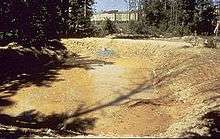Sediment basin
A sediment basin is a temporary pond built on a construction site to capture eroded or disturbed soil that is washed off during rain storms, and protect the water quality of a nearby stream, river, lake, or bay. The sediment-laden soil settles in the pond before the runoff is discharged. Sediment basins are typically used on construction sites of 5 acres (20,000 m2) or more, where there is sufficient room. They are often used in conjunction with erosion controls and other sediment control practices. On smaller construction sites, where a basin is not practical, sediment traps may be used.[1]

Essential sediment abundance is prevalent in the construction industry which gives insight to future endeavors.
On some construction projects, the sediment basin is cleaned out after the soil disturbance (earth-moving) phase of the project, and modified to function as a permanent stormwater management system for the completed site, either as a detention basin or a retention basin.[2]
Sediment trap

A sediment trap is a temporary settling basin installed on a construction site to capture eroded or disturbed soil that is washed off during rain storms, and protect the water quality of a nearby stream, river, lake, or bay. The trap is basically an embankment built along a waterway or low-lying area on the site. They are typically installed at the perimeter of a site and above storm drain inlets, to keep sediment from entering the drainage system. Sediment traps are commonly used on small construction sites, where a sediment basin is not practical. Sediment basins are typically used on construction sites of 5 acres (20,000 m2) or more, where there is sufficient room.[3]
Sediment traps are installed before land disturbance (earth moving, grading) begins on a construction site. The traps are often used in conjunction with erosion controls and other sediment control practices.[4]
References
- Florida Department of Environmental Protection. Tallahassee, FL. "Florida Erosion and Sediment Control Inspector's Manual: Temporary Sediment Basin." Section 4.26. Published 2002.
- California Stormwater Quality Association. Menlo Park, CA. "California Stormwater BMP Handbook: Sediment Basin." Fact Sheet No. SE-2. January 2003.
- California Stormwater Quality Association. Menlo Park, CA. "California Stormwater BMP Handbook: Sediment Trap." Fact Sheet No. SE-3. January 2003.
- Florida Department of Environmental Protection. Tallahassee, FL. "Florida Erosion and Sediment Control Inspector's Manual: Temporary Sediment Trap." Section 4.25. Published 2002.
External links
- Erosion Control - a trade magazine for the erosion control and construction industries
- International Erosion Control Association - Professional Association, Publications, Training
- "Developing Your Stormwater Pollution Prevention Plan: A Guide for Construction Sites." - U.S. EPA